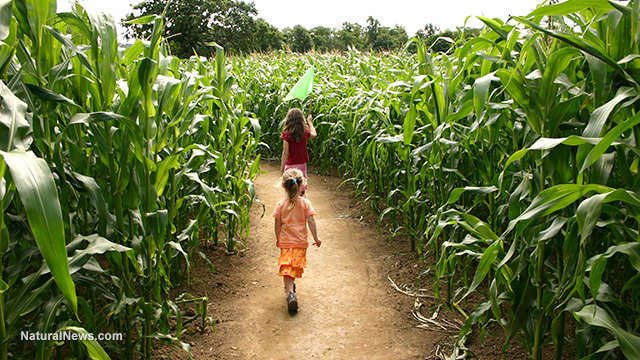Children living in agricultural areas are developing leukemia, brain tumors and other childhood cancers at an accelerated rate
Monday, May 16, 2016 by: Julie Wilson staff writer
Tags: children, agricultural pesticides, childhood cancers

(NaturalNews) Health problems in children have risen significantly in recent years, and the cause is primarily environmental. That's the bottom line of a new report released by the Pesticide Action Network entitled "Kids on the Frontline," which details the harmful and potentially fatal health effects pesticides are having on America's children.
Using government health trend data and recent academic research, PAN found that incidences of cancer, autism, developmental disabilities, ADHD, diabetes and obesity have risen significantly over the last three and a half decades.
Childhood cancers, particularly, are becoming much more common among children living in rural areas where pesticides are routinely applied. From the year 1975 to 2012, childhood cancers rose 36 percent in children aged zero to 19.
Mounting evidence links pesticides to neurodevelopmental harms
"Evidence linking pesticide exposure to increased risk of leukemia and brain tumors continues to mount, with new 'meta-analysis' studies pointing to higher risks among children in rural agricultural areas. Incidence of these two cancers is rising more quickly than other types of childhood cancer," the report found.Health problems related to prenatal pesticide exposure are also on the rise. Mounting evidence highlights the impact prenatal pesticide exposure has on neurological and nervous system development in children. The link was strong in 2012, reports PAN, but it's grown even stronger.
"New studies link increased risk of developmental disorders and delays—including autism spectrum disorder—to prenatal proximity to agricultural fields where pesticides are sprayed."
Children living in agricultural areas essentially get a "double dose" of pesticide exposure. In addition to exposure via food and applications in schools, parks, homes and gardens, children in rural areas face exposure from pesticide drift and water contaminated with farming chemicals.
"In some cases, these children also experience economic and social stressors that can exacerbate the health harms of agricultural chemicals. Across the country, rural children are on the frontlines of pesticide exposure," the report found.
How to protect children from pesticides
Researchers say the best way to protect children from harm caused by pesticides is to "dramatically reduce the volume of use nationwide." This goal is "both achievable and long overdue," says PAN. "The burden of protecting children from dangerous chemicals cannot rest with individual families; policy change is required."For more than a century, pesticide regulations have centered on one concept: getting the products to market. As a result, more than 680 million pounds of pesticides are applied to farm fields each year, according to government data from 2007, the most recent available. When non-agricultural use is included, this number balloons to more than a billion.
"Ever-stronger science shows that even at low levels of exposure, many of these chemicals are harmful to human health—and children's developing minds and bodies are particularly vulnerable. It is also increasingly clear that alternative, less chemical-intensive approaches to farming are not only viable, but would strengthen the resilience of agricultural production."
PAN says it's time regulators establish "an ambitious national use reduction goal for agricultural pesticides." The reduction goal should prioritize action against pesticides most harmful to children, establishing pesticide-free buffer zones around schools, daycares, and other "sensitive sites" near farms where chemicals are used.
Finally, we need to invest in healthy, innovative farming, says PAN.
"We need to provide significant and meaningful support, incentives and recognition for farmers stepping off the pesticide treadmill. National and state programs must prioritize investment in healthy, sustainable and resilient agricultural production."
Eliminating regulatory influence from companies like Monsanto
Stripping away the influence multinational food corporations have on public policy is another important step, says PAN."These multinational entities wield tremendous control over how we grow our food, from setting research agendas in public institutions to production and sale of farm inputs including seeds, fertilizers and pest management products.
"Not surprisingly, these same corporations also hold significant sway in the policy arena, investing millions of dollars every year to influence voters and policymakers at the local, state and federal levels.
"Their aim is to protect the market for pesticides, seeds and other agrichemicals. As public concern about the health impacts of pesticide products has grown in recent years, the pesticide industry has also invested heavily in public relations campaigns to influence the national conversation about food and farming," the report concludes.
For more information on pesticides, click here.
Sources:
PANNA.org[PDF]
PANNA.org
Children at FETCH.news
Get independent news alerts on natural cures, food lab tests, cannabis medicine, science, robotics, drones, privacy and more.
Take Action: Support Natural News by linking to this article from your website
Permalink to this article:
Embed article link: (copy HTML code below):
Reprinting this article:
Non-commercial use OK, cite NaturalNews.com with clickable link.
Follow Natural News on Facebook, Twitter, Google Plus, and Pinterest
- Aerosolized bioweapons? Strange “diploid biomasses” falling out of the sky in Florida captured under the microscope
- Widespread social and economic unrest: Steve Quayle issues urgent financial warning of imminent asset collapse in new interview with Mike Adams
- Kiss Your Genetic Privacy Good-Bye! 23andMe Gets Green Light to Sell Your Intimate Genetic Details to Anyone They Want
- Analysis: The coming economic collapse, a mass uprising and Trump's three secret weapons to halt the growing revolt
- Fauci is back in the limelight, and he’s busy promoting a future COVID or FLU pandemic
- Mike Adams releases country western hit single: Goin’ Back in Time is Comin’ Home
- 8 U.S. states may EXPAND vaccine exemptions in 2025, and parents have many reasons to STOP THE SHOTS
- Israeli lobbyists boast of controlling US national security policy in leaked AIPAC audio
- U.S. lawmakers investigate Meta over alleged China collaboration
- Ancient mummies rewrite human history with “ghost” lineage discovery
- Russia escalates censorship war, targets over 200 VPN apps amid Google resistance
- Surge in KIDNEY FAILURES linked to common medications
- Mel Gibson sparks outcry over 9/11 ‘Biggest Scandal’ remark as unanswered questions resurface
- TAKE IT DOWN Act advances in Congress amid free speech concerns
- DMSO and Natural Dyes: A suppressed cancer treatment resurfaces in independent research
- CLOT SHOT PLANDEMIC UNFOLDING: Fibrous, rubbery clots caused by covid injections have prion-like seeding activity
- Curcumin’s ancient healing power supercharges muscle recovery, and its effects are compounded with anti-inflammatory foods and supplements
- DMSO: Nature's healing solvent with revolutionary potential - from cancer treatment to regenerative medicine
- Israeli lobbyists boast of controlling US national security policy in leaked AIPAC audio
- Aerosolized bioweapons? Strange “diploid biomasses” falling out of the sky in Florida captured under the microscope
- Analysis: The coming economic collapse, a mass uprising and Trump's three secret weapons to halt the growing revolt
- Fauci is back in the limelight, and he’s busy promoting a future COVID or FLU pandemic
- Widespread social and economic unrest: Steve Quayle issues urgent financial warning of imminent asset collapse in new interview with Mike Adams
- Kiss Your Genetic Privacy Good-Bye! 23andMe Gets Green Light to Sell Your Intimate Genetic Details to Anyone They Want
- Mike Adams releases country western hit single: Goin’ Back in Time is Comin’ Home
- U.S. lawmakers investigate Meta over alleged China collaboration
- Tulsi Gabbard leads charge against the Biden regime’s global censorship of the 'Disinformation Dozen'
- Pfizer's RSV vaccine linked to preterm births as drug giant CONCEALED RISKS from pregnant women in unethical clinical trials
- Dane Wigington exposes climate engineering as ‘All-Out Weather and Biological Warfare’
- Shedding light on the dark side of MMR vaccines: How vaccinated individuals SPREAD MEASLES & put the vulnerable at risk
- TAKE IT DOWN Act advances in Congress amid free speech concerns
- CLOT SHOT PLANDEMIC UNFOLDING: Fibrous, rubbery clots caused by covid injections have prion-like seeding activity
- Chemtrails unveiled: How the CIA and Big Business are manipulating the weather for profit
- Curcumin’s ancient healing power supercharges muscle recovery, and its effects are compounded with anti-inflammatory foods and supplements
- Criminal referral requests filed against Fauci and top COVID officials in seven states
- Defunding DEADLY mRNA jabs: Government funding for mRNA technology being scrutinized and sidelined until proven "safe and effective" for real
- Newly released JFK files reveal Pentagon's role in creating Lyme disease and covid in the same lab
- Analysis: The coming economic collapse, a mass uprising and Trump's three secret weapons to halt the growing revolt
- Mike Adams releases country western hit single: Goin’ Back in Time is Comin’ Home
- Aerosolized bioweapons? Strange “diploid biomasses” falling out of the sky in Florida captured under the microscope
- Kiss Your Genetic Privacy Good-Bye! 23andMe Gets Green Light to Sell Your Intimate Genetic Details to Anyone They Want
- European Court of Justice: Healthcare professionals who promoted or administered COVID-19 vaccines are CRIMINALLY LIABLE for any harm caused
- Federal employees whine over DOGE's new directive requiring them to do a 5-point summary of weekly accomplishments
- Widespread social and economic unrest: Steve Quayle issues urgent financial warning of imminent asset collapse in new interview with Mike Adams
- U.S. approves new Russian ambassador as diplomatic thaw continues
- Government waste exposed: Hegseth supports Musk’s demand for accountability from federal workers
- Now you can HEAR chemistry: Health Ranger translates molecules into music in stunning video demonstration that will blow your mind (and your ears)
- Fauci is back in the limelight, and he’s busy promoting a future COVID or FLU pandemic
- CLOT SHOT PLANDEMIC UNFOLDING: Fibrous, rubbery clots caused by covid injections have prion-like seeding activity
- I Want My Bailout Money – new song released by Mike Adams
- I Want My Bailout Money – new song and music video released by Mike Adams
- Tulsi Gabbard leads charge against the Biden regime’s global censorship of the 'Disinformation Dozen'
- Trump administration poised to overhaul crypto regulations with new SEC leadership
- The Health Ranger releases “Vaccine Zombie” song and music video, using AI-animated zombies for the music video
- Red Cross issues warning to stop blood plasma donations from vaccinated people
- Scientists confirm: GENIUS brain function can be spontaneously unleashed in humans without any apparent cause
- EPA advisor admits the agency is funneling billions to climate groups ahead of Trump’s return to White House
- HYSSOP: What research reveals about the health benefits of this ancient holy herb
- Two containers with completed ballots fall out of truck in Florida
- Newly released JFK files reveal Pentagon's role in creating Lyme disease and covid in the same lab
- Global leaders unite to clamp down on “misinformation” with UN-backed Cascais Declaration
- Mike Adams releases country western hit single: Goin’ Back in Time is Comin’ Home
- BREAKING: 2025 NDAA authorizes mandatory military draft of WOMEN across America… as Pentagon pursues global NUCLEAR war with both Russia and China at the same time
- Michael Yon warns of a ZIONIST TAKEOVER in Trump’s second administration
- The Health Ranger releases “Vaccine Zombie” song and music video, using AI-animated zombies for the music video
- Ozempic and Wegovy weight loss drugs are injectable LIZARD VENOM PEPTIDES that may unleash a devastating wave of organ failure… side effects align with symptoms of SNAKE BITES
- BOMBSHELL: DNA testing kits are a SCAM to develop ethnic-specific bioweapons
- Israeli soldiers accused of even more torture and abuse in the West Bank
- I Want My Bailout Money – new song released by Mike Adams
- These 13 countries just signed an agreement to engineer a global FAMINE by destroying food supply
- NASA admits that climate change occurs because of changes in Earth’s solar orbit, and NOT because of SUVs and fossil fuels
- RFK Jr. clears key hurdle: Sen. Susan Collins backs controversial HHS nominee, signaling a new era for health policy
Science News & Studies
Medicine News and Information
Food News & Studies
Health News & Studies
Herbs News & Information
Pollution News & Studies
Cancer News & Studies
Climate News & Studies
Survival News & Information
Gear News & Information
News covering technology, stocks, hackers, and more



"Big Tech and mainstream media are constantly trying to silence the independent voices that dare to bring you the truth about toxic food ingredients, dangerous medications and the failed, fraudulent science of the profit-driven medical establishment.
Email is one of the best ways to make sure you stay informed, without the censorship of the tech giants (Google, Apple, Facebook, Twitter, YouTube, etc.). Stay informed and you'll even likely learn information that may help save your own life."
–The Health Ranger, Mike Adams












































